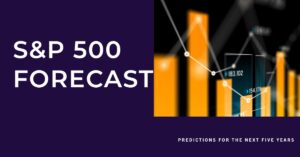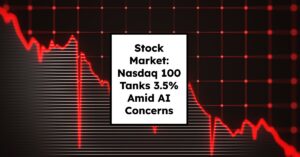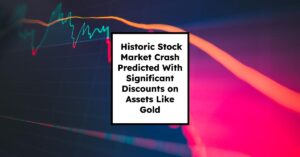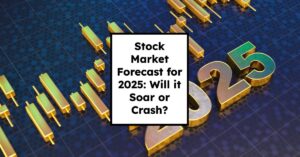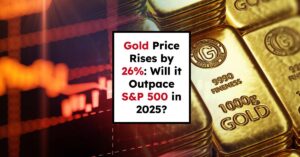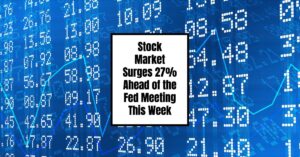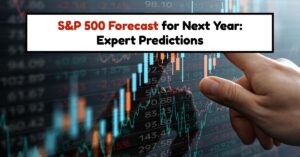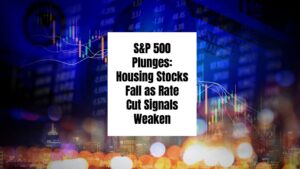Let's talk about where the S&P 500 might be heading over the next five years. Here's the short of it: Current predictions, as of early 2025, point towards a generally positive outlook, with some significant growth expected, especially in 2025 itself. Most analysts are anticipating a solid annual increase for the index. But it’s not quite that simple, of course.
This is a dynamic environment, and these are just predictions. What I want to do here is delve a bit deeper than just the surface level numbers and give you a real sense of the factors driving those forecasts, and some of the things I’m personally keeping a close eye on as an investor.
S&P 500 Forecasts and Predictions for Next Five Years
The Optimism of 2025: A Closer Look
Right off the bat, the buzz around 2025 is pretty strong. We're seeing a lot of analysts circling around a roughly 10% increase in the S&P 500 this year. That's a pretty exciting jump for those of us with money in the market. If you’ve been on the fence about investing, this is one of those data points that might nudge you towards pulling the trigger.
Specifically, J.P. Morgan has been one of the most vocal, pegging a year-end target of around 6,500 for the S&P. That's a pretty bold call, and it’s not just guesswork. They’re basing this on some key growth sectors, particularly in tech. It's not just J.P. Morgan either; firms like Morgan Stanley and Goldman Sachs have been sending similar signals. They see strong revenue and earnings growth, and even with potential economic bumps ahead like interest rate fluctuations and a bit of lingering inflation, they're still bullish.
Of course, there's some range in these forecasts. While many see the index climbing steadily, you also have predictions that go even further. Some speculate, and I think this is worth considering, that we could even see the S&P 500 hit 7,000 or even 7,500 by 2027. For that to happen, economic conditions would need to stay on the positive side of the ledger. So, it's not a guarantee, but definitely something to keep in mind as a possibility.
Here's a quick table to visualize some of the key forecasts for 2025:
| Firm | 2025 Year-End Target (Approx.) | Key Drivers |
|---|---|---|
| J.P. Morgan | 6,500 | Tech growth |
| Morgan Stanley | Similar to J.P. Morgan | Revenue & Earnings |
| Goldman Sachs | Similar to J.P. Morgan | Revenue & Earnings |
| Investment Bank Forecasts | 6,500 to 7,000+ | Economic Stability |
The Economic Puzzle: Understanding the Forces at Play
Okay, so why all the optimism? Well, it’s not just a feeling; it’s tied to some pretty crucial economic factors. These are the things I’m always looking at, and they give me an idea of the real health of the market:
- Interest Rates: The Fed's Tightrope Walk: The Federal Reserve's decisions around interest rates are absolutely critical here. I’ve learned from experience that how they handle rates can send the market soaring or sinking, which is why I watch this like a hawk. Most analysts (and myself) believe the Fed is going to try to maintain a steady path through much of 2025. But the big question is, what happens with inflation? Any decisions they make about trying to slow things down could shake market confidence. The goal is a Goldilocks scenario where rates aren't too high, putting a damper on things, but also not too low, risking inflation.
- Inflation: Finding the Balance: Inflation has been a hot topic for a while now, and as we move further into 2025, I'm cautiously optimistic about this. The hope is that we'll see inflationary pressures ease up. When that happens, consumers are more likely to spend, businesses are likely to be more profitable, and that's good for the stock market.
- Geopolitics: The Wildcard: Let’s face it, the world is a complex place. Geopolitical events, from trade deals to conflicts, can massively impact market expectations. I can't stress enough how important it is to stay informed about these developments because they can very quickly throw a wrench into even the best forecasts.
- Technology's Driving Force: Technology is an area that I am particularly excited about. The growth of AI, biotechnology, and renewable energy is creating new opportunities for businesses. I believe that these sectors have the potential to not only drive stock prices higher but also change the way we live our lives.
Sector by Sector: Who's Winning and Who's Lagging?
The S&P 500 isn't a monolithic block; it's made up of a whole variety of sectors. And those sectors don't all move together. It's very helpful to understand who’s leading the charge, and who's struggling. Based on the data, here’s a quick breakdown:
- Technology: The Undisputed Leader: The tech sector is predicted to be the star of the show. The increasing demand for everything AI-driven is simply huge, and I believe the market will see continued growth in this space.
- Healthcare: Riding the Demographic Wave: With the aging population and overall demand for better healthcare, this sector is looking pretty promising. I believe the trend towards personalized medicine and preventative healthcare will lead to growth for many companies in this area.
- Financials: Steady as She Goes: I see the financials sector also showing solid growth. This makes sense, given the broader economic context.
However, not all areas are seeing the same sunny outlook:
- Energy: Navigating a Changing Landscape: Energy is a bit of a mixed bag. The world is shifting towards renewables, so I think it's crucial to be selective about your investments in this area.
- Traditional Retail: Consumer Behavior Shifts: Traditional retail is facing challenges as consumer shopping habits are changing, which is why I am more inclined towards looking at e-commerce stocks instead of the brick-and-mortar stores.
Looking Long-Term: 2026 to 2030
Okay, so what happens after 2025? That’s where things get a bit less specific but still pretty interesting. The general expectation is that growth will continue, but maybe not at the same high rate we're seeing in 2025.
- Steady Growth, but Not a Straight Line: Analysts are predicting a Compounded Annual Growth Rate (CAGR) of around 5% to 8% for the S&P 500 in the five years between 2026 and 2030. By 2030, some projections are throwing out a figure of around 8,000 for the index, which, if it comes to pass, would be pretty incredible.
- The Importance of Realism: As an investor, I’ve learned that the best approach is a balanced one. While there's good reason to feel optimistic, it's also important to be realistic and to remember that things aren’t always predictable. Things like economic downturns, financial crises, or major geopolitical events can all trigger market corrections. A little bit of risk management, I believe, goes a long way.
Here’s a quick table summarizing the long-term outlook:
| Time Frame | Predicted CAGR (Approx.) | Potential S&P 500 Level | Notes |
|---|---|---|---|
| 2026 – 2030 | 5% to 8% | Around 8,000 by 2030 | Contingent on stable economic conditions |
My Takeaway: Informed Investing is Key
What I always come back to is that the market is dynamic, and a lot of things can change. The best approach is to not just blindly trust the predictions; do your own research and think for yourself. It's crucial to pay close attention to things like:
- Diversification: Don't put all your eggs in one basket. Investing across different sectors, and even different asset classes, can protect you from wild swings in the market.
- Long-Term Perspective: I believe in the power of long-term investing. Trying to time the market is something I've learned is far more trouble than it's worth. Focus on your goals, have a solid strategy, and you’ll be more likely to succeed in the long run.
- Stay Informed: Keep an eye on those economic factors we discussed earlier: interest rates, inflation, geopolitics, tech innovation, etc. They're the things that are really driving market behavior.
- Seek Professional Help: I'm a big believer in getting good advice. If you're not sure how to manage your investments, find a good advisor.
Final Thoughts: Navigating the Future
The S&P 500 is, in my view, showing real promise over the next five years. We're talking about growth driven by tech, innovation, and overall economic strength. But it's not all smooth sailing. We’ll have to keep our eyes on things like economic stability, geopolitics, and market corrections. I, personally, am optimistic, but I'm also a realist. My own investing strategy is always built on a diversified portfolio, and that's something I'd encourage you to think about as well. Ultimately, the key to success is knowledge, patience, and a strategic mindset.
Secure Your Wealth Beyond the S&P 500 with Norada in 2025
While the S&P 500 Forecast and predictions spark debate,
explore turnkey real estate investments for steady, reliable returns.
Diversify your portfolio with high-quality, ready-to-rent properties
that offer consistent income and long-term financial security.
Speak with our expert investment counselors (No Obligation):
(800) 611-3060
Read More:
- Gold Price Rises by 26%: Will it Outpace S&P 500 in 2025?
- S&P 500 Forecast for the Next Year: What to Expect in 2025?
- Stock Market Predictions for the Next 5 Years
- Billionaire Warns of Stock Market Crash If Harris Wins Elections
- Stock Market is Predicted to Surge Regardless of the Election Outcome
- Echoes of 1987: Is Today’s Stock Market Crash Leading to a Recession?
- Is the Bull Market Over? What History Says About the Stock Market Crash
- Wall Street Bear Predicts a Historic Stock Market Crash Like 1929
- Economist Predicts Stock Market Crash Worse Than 2008 Crisis
- Stock Market Forecast Next 6 Months
- Next Stock Market Crash Prediction: Is a Crash Coming Soon?
- Stock Market Crash: 30% Correction Predicted by Top Forecaster
